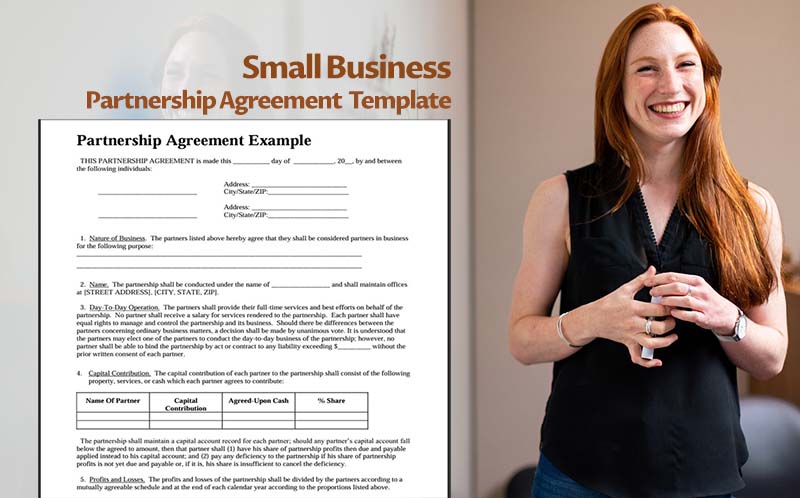A partnership agreement is a critical legal document that sets the foundation for a business partnership. It outlines the terms, roles, responsibilities, and expectations for all partners involved. A partnership agreement template is a pre-designed framework that simplifies the process of creating this agreement, ensuring that key elements are included and providing a structure to customize according to specific needs. This article explores the significance of partnership agreements, the benefits of using templates, and the essential components to consider when drafting one.
The Importance of Partnership Agreements
When two or more people join forces to start a business, they must have a clear understanding of their roles and obligations. A partnership agreements acts as a blueprint, detailing the governance structure, profit-sharing arrangements, decision-making processes, and dispute resolution mechanisms. Without a formal agreement, partnerships risk misunderstandings, disputes, and even legal battles that could jeopardize the business.
Benefits of Using a Partnership Agreements
Using a template offers several advantages:
- Time and Cost Efficiency: Templates provide a ready-made framework, reducing the time and effort required to draft an agreement from scratch. This can also save costs associated with extensive legal consultations.
- Comprehensive Coverage: Partnership agreement templates are designed to cover all essential aspects of a partnership, from initial contributions to exit strategies. This ensures that critical topics are not overlooked.
- Customization: While templates offer a structured format, they also allow for customization to meet specific business needs. This flexibility ensures that the agreement reflects the unique dynamics of the partnership.
General Partnership Agreement -PDF
Small Business Partnership Agreement Template
Business Partnership Agreement
Essential Components of a Partnership Agreement Template
A well-constructed partnership agreement template should include the following key elements:
- Partnership Structure: Define the type of partnership (general or limited) and outline the roles and responsibilities of each partner.
- Capital Contributions: Detail the initial contributions, whether financial or non-financial, and outline any future contributions required.
- Profit and Loss Sharing: Describe how profits and losses will be distributed among partners.
- Management and Decision-Making: Define the governance structure, including voting rights, authority, and decision-making processes.
- Partnership Duration and Exit Strategies: Indicate the duration of the partnership and the procedures for adding or removing partners, as well as the process for dissolving the partnership if necessary.
- Dispute Resolution: Establish mechanisms for resolving disputes, such as mediation or arbitration, to avoid costly litigation.
- Confidentiality and Non-Compete Clauses: Outline the expectations for confidentiality and any non-compete agreements.
A partnership agreement template is a valuable resource for anyone entering a business partnership. It ensures that all key elements are addressed and provides a solid foundation for a successful and harmonious business relationship. While templates are a great starting point, it’s essential to have the final agreement reviewed by legal professionals to ensure compliance with local laws and regulations.
FAQs:
A partnership agreement is an essential document that outlines the terms and conditions of a business partnership. Below are some frequently asked questions (FAQs) to help you understand the key aspects of a partnership agreement and why it’s important.
1. What is a partnership agreement?
A partnership agreement is a legally binding document that outlines the terms, roles, responsibilities, and obligations of the partners in a business partnership. It covers aspects such as profit sharing, decision-making processes, management roles, and exit strategies.
2. Why do I need a partnership agreement?
A partnership agreement helps prevent misunderstandings and disputes by clearly defining the expectations and responsibilities of each partner. It provides a framework for resolving conflicts and guides the partnership’s operations, ensuring all partners understand their rights and obligations.
3. What should a partnership agreement include?
A partnership agreement should cover several key components, including:
- Partnership structure: The type of partnership (general, limited, etc.), roles, and responsibilities.
- Capital contributions: Initial and future contributions from each partner.
- Profit and loss distribution: How profits and losses are divided among partners.
- Decision-making processes: How decisions are made and what to do in case of a dispute.
- Management and governance: Management roles and structure.
- Exit strategies: Processes for partners to leave the partnership and handle ownership transitions.
4. Can I use a template for a partnership agreement?
Yes, a partnership agreement template can be a useful starting point. However, it’s crucial to tailor the template to your specific partnership needs. A template provides a framework but should be customized to ensure it aligns with your partnership’s unique circumstances.
5. How are profits and losses typically divided in a partnership agreement?
Profits and losses are generally divided based on each partner’s capital contribution or as agreed upon by the partners. It’s important to specify the profit-sharing ratio in the agreement to avoid future misunderstandings.
6. What happens if there is a dispute among partners?
A partnership agreement should include a dispute resolution clause that outlines the process for resolving conflicts, such as mediation or arbitration. This clause helps manage disagreements without resorting to costly legal battles.
7. How can a partner leave a partnership?
The partnership agreement should detail the process for a partner’s exit, whether through voluntary withdrawal, retirement, or other means. It should also address the valuation of the departing partner’s interest and how it will be transferred or distributed.
8. Is it necessary to involve a lawyer in creating a partnership agreement?
While it’s possible to create a partnership agreement without legal assistance, involving a lawyer is highly recommended. A lawyer can help ensure the agreement complies with relevant laws, addresses all necessary components, and protects the interests of all parties involved.
9. Can a partnership agreement be changed after it’s signed?
Yes, a partnership agreement can be amended after it’s signed, but any changes typically require the consent of all partners. It’s important to include an amendment clause in the agreement that specifies the process for making changes.
10. What happens if a partnership agreement doesn’t exist?
Without a partnership agreement, partners may rely on state laws to determine the rules for operating the partnership. This can lead to misunderstandings and conflicts, as default laws may not align with the partners’ expectations. A written partnership agreement helps avoid these issues by providing clear guidelines for the partnership.



